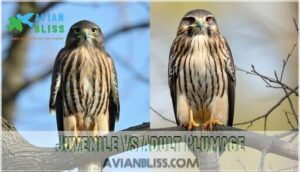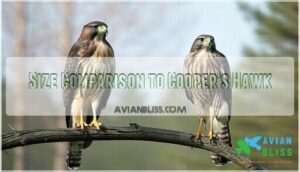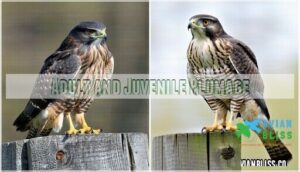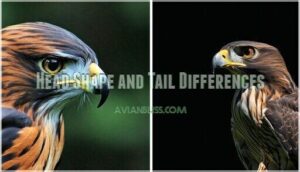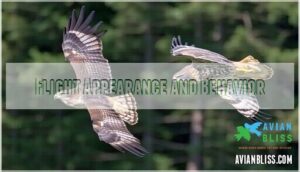This site is supported by our readers. We may earn a commission, at no cost to you, if you purchase through links.
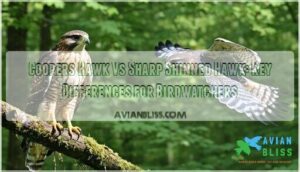
You’ll notice Cooper’s hawks are crow-sized with square heads and dark caps, while sharp-shinned hawks are jay-sized with rounder heads.
Cooper’s have rounded tail tips that look like they’ve been dipped in white paint, whereas sharp-shinned tails appear square-cut.
In flight, Cooper’s project their larger heads forward like they’re surveying their kingdom, while sharp-shinned hawks keep a more compact profile.
Size overlap between small male Cooper’s and large female sharp-shinned makes things tricky, but these subtle clues will help you crack the code to identify Cooper’s hawks and understand the size overlap.
Table Of Contents
- Key Takeaways
- Cooper’s Hawk Identification
- Sharp Shinned Hawk Identification
- Hawk Size Comparison
- Head Shape and Tail Differences
- Flight Appearance and Behavior
- Frequently Asked Questions (FAQs)
- How rare is it to see a Cooper’s hawk?
- What hawk is similar to the Cooper’s hawk?
- How to tell the difference between a Cooper’s hawk and a Sharp-Shinned?
- How do I identify a Cooper’s hawk?
- What is the difference between a northern Goshawk and a sharp-shinned hawk?
- What is the difference between a Cooper’s hawk and a northern Harrier?
- What are their preferred hunting techniques and prey?
- How do their vocalizations differ?
- What habitats do these hawks typically occupy?
- How do their migration patterns compare?
- Conclusion
Key Takeaways
- You’ll identify Cooper’s hawks by their crow-sized bodies and blocky heads, while sharp-shinned hawks are jay-sized with small, rounded heads that appear bug-eyed
- Look for tail shape differences – Cooper’s hawks have rounded tail tips with white edges, while sharp-shinned hawks display square-cut tails without white trim
- Watch their flight patterns closely – Cooper’s hawks project their heads forward during flight with steady wingbeats, while sharp-shinned hawks keep compact profiles with quick, snappy wingbeats
- Remember that size overlap between large female sharp-shinned hawks and small male Cooper’s hawks creates confusion, so you’ll need to rely on multiple identifying features rather than size alone
Cooper’s Hawk Identification
When you spot a Cooper’s Hawk, look for its hefty, crow-like body and a big blocky head that could rival a football helmet.
If you catch yourself squinting at a backyard visitor with a stern stare and a tail that curves like a “C”, you’ve probably found your bird—just don’t expect it to pose for a selfie.
Size and Weight
You’ll almost always spot the Cooper’s Hawk by its robust body and crow-like size.
Don’t get tricked by size deception—sexually dimorphic hawks mean females tower over males! Sometimes, weight overlap adds to the confusion.
Use measurement metrics for any hawk size comparison. Knowing the average hawk dimensions can greatly aid identification.
In short, sharp shinned hawks look dainty, while Cooper’s bring bouncer energy to your backyard.
Head Shape and Nape Color
If size throws you off, shift focus to head shape and nape color. A Cooper’s Hawk’s head is blocky and big, topped with pale nape feathers for that “capped” look.
Check the stern facial expression and eye placement close to the beak—kind of like a grumpy librarian. Many enthusiasts even purchase Coopers hawk merchandise to show their appreciation.
- Spot those “capped” nape feathers
- Blocky head = Cooper’s Hawk
- Eye placement helps with hawk identification
Tail Shape and Flight Characteristics
While head shape can help, pay close attention to tail shape and flight characteristics for hawk identification.
Cooper’s Hawk shows a rounded tail with bold Tail Bands and a white tip, plus head projection during flight.
Its Wingbeats are deep and steady, followed by a smooth gliding style.
One key difference between the two species is their size and build.
If you blink, you might miss its impressive flight speed!
Juvenile Vs Adult Plumage
Juvenile plumage on a Cooper’s Hawk throws you for a loop—think brown stripes on the chest (not those grown-up bars).
As for adult markings, you’ll spot that blue-gray back and orange chest. Eye color? Youngsters have yellow, adults turn orange-red.
Nape contrast stands out in grown birds. Their stealthy hunting strategies are key to their survival.
- Brown stripes (juvenile)
- Blue-gray backs (adult)
- Orange chest (adult)
- Shifting eye color
Sharp Shinned Hawk Identification
When you spot a Sharp-shinned Hawk, pay close attention to its petite frame and bug-eyed look—think of a Blue Jay with a secret superhero disguise.
It’s tricky not to confuse it with a Cooper’s Hawk, but once you notice that small, rounded head and snappy, flapping flight, you’ll be one step ahead in the hawk-spotting game.
Distinguishing Features
After exploring Cooper’s Hawk traits, let’s look at sharp shinned hawk identification.
Spot their small, rounded heads, bug-eyed look, and sleek legs.
Their plumage details are browner in young birds, shifting as they age.
Listen for distinct, high-pitched vocalizations.
Sharp-shinned hawks primarily hunt small birds like sparrows.
Compare eye color and body proportions—they’re all part of the hawk vs hawk puzzle.
| Feature | Sharp-shinned Hawk | Cooper’s Hawk |
|---|---|---|
| Eye Color | Yellow/Red | Orange/Red |
| Leg Markings | Thin, long | Thick, moderate |
| Plumage Details | Streaky brown (juvenile); uniform adult | Lighter, capped nape |
Size Comparison to Cooper’s Hawk
Picture a game of “hawk vs hawk”—the Cooper’s Hawk comes in beefier and broader, almost crow-like, while the Sharp-shinned Hawk is dainty and quick, more like a Blue Jay.
Size difference matters: Relative Dimensions and Weight Distribution reveal a real gap, though Sexual Dimorphism and Regional Variations sometimes muddy the waters of sharp shinned hawk identification.
You can find products related to Coopers hawk size online.
Plumage Correlation? That’s another story!
Flight Pattern and Tail Shape
Sharp-shinned Hawks zip through trees with quick, snappy wingbeats that look choppy compared to Cooper’s deeper strokes.
Sharp-shinned Hawks dart through the trees with choppy, snappy wingbeats, like feathered acrobats weaving through a leafy obstacle course.
You’ll notice their square tail shape lacks the white edging, and their smaller head creates a T-shaped flight silhouette.
Their gliding style uses straighter wings, while their incredible flight agility lets them dart through dense branches like feathered ninjas chasing songbirds.
Their tail tip coloring is also a key identifier.
Adult and Juvenile Plumage
Age determines your first identification step.
Juvenile Sharp-shinned Hawks display brown backs with vertical chest stripes, while adults show blue-gray backs with horizontal orange barring.
Eye color changes from pale yellow in juveniles to orange-red in adults.
Unlike Cooper’s Hawks, Sharp-shinned Hawks maintain uniform nape coloration without the distinctive capped appearance, making plumage development patterns key identification markers, and this is crucial for distinguishing them based on their uniform nape coloration.
Hawk Size Comparison
When you’re trying to tell these two hawk species apart, size becomes your most reliable field mark.
Cooper’s Hawks measure 14-20 inches long with a 24-37 inch wingspan, while Sharp-shinned Hawks are much smaller at just 9-13 inches long with a 16-26 inch wingspan.
Length and Wingspan
When comparing these raptors, you’ll notice clear size differences that help with identification.
Cooper’s hawks measure 14-20 inches long with 24-37 inch wingspans, while sharp-shinned hawks are smaller at 9-13 inches with 16-26 inch spans.
Sexual dimorphism creates size overlap between large female sharp-shinned hawks and small male Cooper’s hawks, making measurement accuracy essential for proper identification.
| Feature | Cooper’s Hawk | Sharp-shinned Hawk |
|---|---|---|
| Average Length | 14-20 inches | 9-13 inches |
| Average Wingspan | 24-37 inches | 16-26 inches |
| Size Comparison | Crow-sized | Blue Jay-sized |
| Wing Chord | No overlap between species | Distinct measurements |
| Regional Variations | Consistent sizing | Some western differences |
Weight and Sex Differences
Weight differences between these hawks reveal fascinating sexual dimorphism. Female Cooper’s Hawks outweigh males by 35-40%, while Sharp-shinned females are 75-100% heavier than males.
Eastern weights exceed western weights in both species. This size difference creates minimal size overlap between sexes, making weight a reliable identification tool despite weight variation across regions.
| Species & Sex | Weight Range |
|---|---|
| Cooper’s Male | 220-410g |
| Cooper’s Female | 330-701g |
| Sharp-shinned Male | 87-114g |
| Sharp-shinned Female | 150-218g |
Overlap in Size and Weight
Size Misconceptions happen when you try comparing these hawks solo.
Sexual Dimorphism creates tricky overlaps—large female Sharp-shinned Hawks can rival small male Cooper’s Hawks in size.
Regional Variation adds complexity, especially out west where Weight Overlap between species increases.
| Measurement | Cooper’s Hawk | Sharp-shinned Hawk |
|---|---|---|
| Female Weight | 330-680g | 150-219g |
| Male Weight | 220-410g | 82-115g |
| Measurement Challenges | Crop content affects accuracy | Emaciation skews data |
| Western Overlap | Small males approach large females | Large females near small males |
| Size Comparison Tips | Use multiple features | Avoid single-bird ID |
To improve Size Comparison, it’s essential to consider multiple factors, as Regional Variation and Sexual Dimorphism can lead to Size Misconceptions.
Always follow Size Comparison Tips to ensure accurate identification.
Head Shape and Tail Differences
You’ll spot surprising differences in head shape and tail tips once you know what to look for—think of one as carrying a football helmet and the other a bicycle helmet.
Get ready to check out those tails, too; one’s got a rounded end like a spoon, while the other’s flat as a ruler, making them easy to tell apart if you catch the right angle with a ruler.
Cooper’s Hawk Head Shape
You’ll recognize a Cooper’s hawk by its distinctive blocky head that looks disproportionately large for its body.
This stern expression comes from the hawk’s smaller eyes positioned closer to its beak, creating that intimidating "don’t mess with me" look.
Adult Cooper’s hawks also show lighter nape feathers behind their dark cap, giving them a capped appearance that’s quite striking when you spot one perched nearby.
Sharp Shinned Hawk Head Shape
Sharp-shinned Hawks sport small, rounded heads that look perfectly proportioned—nothing like their Cooper’s cousins.
You’ll notice their bug-eyed look immediately, with large eyes that seem to bulge from their compact skulls. Juvenile head shapes stay smooth and streamlined, lacking any prominent crown features.
Adults maintain uniform nape color that matches their blue-gray heads, without the capped appearance of Cooper’s Hawks. Some Sharp-shinned Hawks show a white superciliary stripe above their eyes.
They’re known to thrive in dense coniferous forests, but can also adapt to suburban areas.
Tail Shape and Flight Posture
Beyond wing position, tail roundness becomes your hawk identification game-changer.
Cooper’s hawk displays a rounded tail tip resembling the letter "C," while Sharp-shinned hawk shows a square, straight-edged tail.
During gliding style observations, Cooper’s holds wings straighter with deeper rowing flaps, and Sharp-shinned exhibits bent wings and snappy wingbeats.
Both species achieve impressive flight speed and maneuverability through dense forests using their distinctive bird tail shape differences.
Flight Appearance and Behavior
When you spot a Cooper’s Hawk or a Sharp-shinned Hawk in flight, you’ll notice they each have a unique style and flair—kind of like two kids racing their bikes through an obstacle course.
Recognizing their moves helps you tell them apart and makes birdwatching way more fun (plus, you get bragging rights if you’re right).
Cooper’s Hawk Flight Pattern
When you spot a Cooper’s hawk in flight, you’ll notice its powerful wingbeat style that alternates between deep, rowing flaps and steady glides.
This accipiter hawk holds its wings nearly straight with a slight upward angle during gliding posture, projecting confidence like a seasoned pilot.
Cooper’s hawks maintain impressive flight speed while demonstrating superior soaring ability compared to their smaller cousins, making their hunting flight appear effortless and controlled.
Sharp Shinned Hawk Flight Pattern
Quick bursts define this sharpshinned hawk’s flight style, with rapid, snappy wingbeats creating a distinctly buoyant flight pattern.
You’ll notice their wrist position thrusts forward during gliding, unlike other accipiter hawks.
This migration flight technique gives them remarkable agility, making hawk identification easier when you spot their characteristic choppy wingbeat frequency and unique gliding style.
Their agility is enhanced by square-tipped tails.
Agility and Speed in Flight
Both accipiter hawks showcase remarkable aerial prowess when chasing prey through dense forests.
You’ll notice their wingbeat frequency and turning radius create distinct flight adaptations.
Cooper’s hawk maintains steadier flight patterns with powerful wingbeats, while Sharp-shinned hawk displays more erratic, snappy movements during hunting dives at top speed.
Here are 5 key agility and speed differences:
- Wingbeat Frequency: Sharp-shinned hawks use rapid, snappy wingbeats while Cooper’s hawks employ steady, powerful strokes
- Turning Radius: Sharp-shinned hawks make tighter turns through dense cover with their smaller frame
- Top Speed: Both reach 50+ mph, but Sharp-shinned hawks clock up to 60 mph in short bursts
- Hunting Dive Style: Cooper’s hawks use sustained pursuits while Sharp-shinned hawks prefer quick ambush attacks
- Flight Adaptations: Sharp-shinned hawks show more buoyant, erratic flight patterns compared to Cooper’s steadier glides
Hunting Behavior and Habitat
You’ll find coopers hawk and sharpshinned hawk behavior differs dramatically when hunting.
Cooper’s hawks persistently chase prey, even pursuing on foot if needed, while sharp-shinned hawks abandon unsuccessful hunts quickly.
Both species exploit habitat overlap around bird feeders, but Cooper’s hawks show better urban adaptation.
Seasonal changes affect their prey selection and hunting techniques substantially.
Frequently Asked Questions (FAQs)
How rare is it to see a Cooper’s hawk?
Nearly 80% of North American bird watchers report seeing Cooper’s Hawks regularly at feeders.
You’ll likely encounter these common woodland hawks cruising forest edges or suburban neighborhoods, making them one of the more accessible raptors.
What hawk is similar to the Cooper’s hawk?
Sharp-shinned Hawks are most similar to Cooper’s Hawks. You’ll find these two accipiters nearly identical in appearance, behavior, and habitat preferences, making identification between them one of birding’s toughest challenges.
How to tell the difference between a Cooper’s hawk and a Sharp-Shinned?
Like spotting twins in a crowd, you’ll look at head size first.
Cooper’s Hawks have chunky, block-like heads while Sharp-shinned Hawks sport tiny, rounded noggins that seem almost bug-eyed in comparison.
How do I identify a Cooper’s hawk?
Cooper’s Hawks display crow-sized bodies with block-shaped heads and rounded tail tips. You’ll notice their stern expression, orange-barred chest (adults), and distinctive flight pattern featuring straight wings during glides.
What is the difference between a northern Goshawk and a sharp-shinned hawk?
Goshawks dwarf sharp-shinned hawks—they’re roughly twice the size with broader wings and fiercer expressions.
You’ll spot goshawks’ distinctive white eyebrow stripe and gray-barred chest, while sharp-shinneds show thin brown stripes and bug-eyed looks.
What is the difference between a Cooper’s hawk and a northern Harrier?
You’ll notice a Cooper’s hawk has a chunky build with a rounded tail.
While a northern harrier appears slimmer with distinctively long wings and flies low over fields rather than through forests.
What are their preferred hunting techniques and prey?
Both hawks are stealth assassins at bird feeders, but they’ve got different styles.
You’ll spot Cooper’s targeting medium songbirds like robins, while sharp-shinned hawks prefer smaller prey like finches and sparrows.
How do their vocalizations differ?
You’ll notice the vocal differences right away – Cooper’s Hawks have a slower, lower-pitched "cak-cak-cak" sound.
While Sharp-shinned Hawks have a higher-pitched, faster "kik-kik-kik."
Think of it as the difference between a deep chuckle and excited chatter.
What habitats do these hawks typically occupy?
Both species thrive in 95% of North America’s wooded habitats.
You’ll find them hunting songbirds in dense forests, suburban neighborhoods with mature trees, parks, and woodlands.
They’re woodland specialists who’ve adapted brilliantly to human-modified landscapes.
How do their migration patterns compare?
Sharp-shinned hawks migrate larger distances seasonally, while many Cooper’s hawks remain permanent residents in the lower 48 when food’s available.
Sharp-shinneds average 3,374 km migrations versus Cooper’s 2,926 km.
Both follow typical accipiter timing patterns during fall southward movements.
Conclusion
Practice makes perfect when mastering the coopers hawk vs sharp shinned hawk identification challenge.
You’ll become more confident spotting these similar raptors by focusing on head shape, tail characteristics, and flight patterns.
Remember that size overlap between species creates confusion, but consistent observation of key features will sharpen your skills.
With patience and these reliable field marks, you’ll distinguish Cooper’s hawks from sharp-shinned hawks like a seasoned birder.
- https://dnr.illinois.gov/education/wildaboutpages/wildaboutbirds/wildaboutbirdsraptors/family---accipitridae/wabsharpshinnedhawk.html
- https://birdwatchingnc.com/coopers-hawk-vs-sharp-shinned-hawk-id/
- https://www.flockingaround.com/post/sharp-shinned-hawk-vs-coopers-hawk-identification
- https://www.audubon.org/field-guide/bird/coopers-hawk
- https://www.hawkmountain.org/raptors/sharp-shinned-hawk




